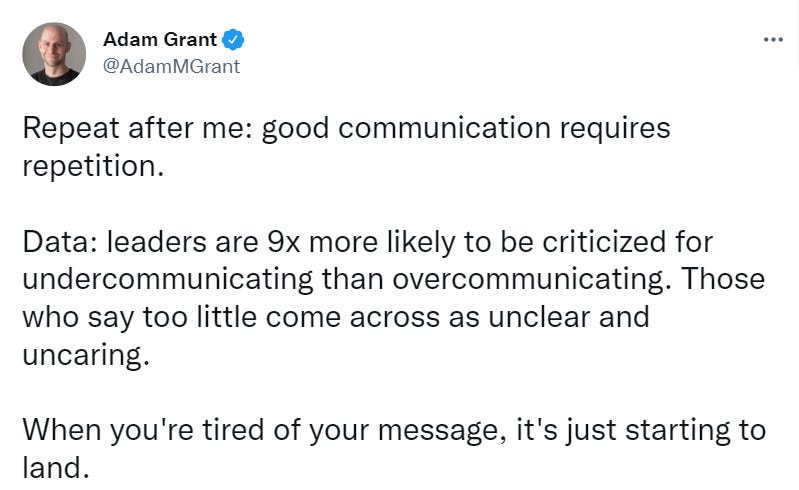Improve Your Team Communication with Repetition: The Rule of 7
As the manuscript deadline for Team Habits approaches (just a few weeks left now!), Charlie is heads down on writing, along with everything else he has going on. For Angela, it's been much the same with all of her CFO responsibilities.
And while it’s been great to have the founders doing that heavy lifting, having them out of the day-to-day business has shown a need for different team habits. Particularly we've had to level up our communication and coordination (what Charlie calls C2) on the team.
Good communication is hard, y’all.
Whether it’s a personal relationship, friendship, or work, communication is critical to the sustainability of our connections.
I’m reminded of a couple of things about communication from my “past lives” that I’m going back to as we at Team PF (and Momentum!) navigate these new workways. Perhaps they’ll help you with your own communications, too.
This time I’ll be covering the Rule of 7; next time I’ll cover the 4Cs.
The Rule of 7
Back in my college days, one of my Communications courses (actually a lot of them) talked about the “Rule of 7.” This was primarily related to marketing/advertising, where it’s said that a customer needs to see/hear a message at least seven times before they’ll take action on it.
(This was before the days of social media; today that number is likely higher than seven for a message to be heard above all the noise.)
Using the Rule of 7 to Over-communicate
That said, I think the Rule of 7 is a good place to start when communicating and coordinating with one’s team. Consider how and how often you communicate a particular message to your team: whether it’s quarterly priorities, project handoffs, company values, or other important information. With everything else your team has going on, is communicating those things once or twice enough for everyone to absorb the information and act?
I’d argue it’s not. I’m in favor of over-communication (even though I’m sometimes not as good with this as I’d like). Charlie recently shared a tweet from Adam Grant that encapsulates this idea:
This leads me to one additional idea: the primary job of a leader is to communicate. That is, to articulate a compelling vision of where the team is going. Then it’s up to the team to figure out how they’ll get there.
Multiple Modes of Communication
The other aspect of the Rule of 7 relates to how we effectively repeat messages to our teams.
The best way to get your point across without your team missing information or tuning out? Combine the repetition of the Rule of 7 with multiple modes to convey the information.
Just like marketing folks use different modes (print, image, video, short form, or long form) to convey a message to as many people as possible, I suggest using as many different modes to communicate to your team as you can muster.
There are a couple of important reasons for this:
Clarity. Sometimes the point makes more sense in a certain mode (“A picture is worth a thousand words,” anyone?), or a combination of modes creates a clearer understanding of the message.
Learning Style. Every person on your team absorbs information differently, with a unique mix of learning style preferences/strengths (visual, auditory, kinesthetic).
Variety. Sometimes a message needs to be communicated in several different ways to be fully understood. Even using the same mode, but conveying the message in a slightly different way may help the lightbulb come on for someone where the previous messages did not. Variety also helps keep the receiver engaged, which is important in our overstimulating world.
At Team PF, we have a bunch of modes/tools we use to C2 with the team:
Slack for short conversations, or providing instructions or clarifications.
Confluence for longer communications like objectives, project briefs, and company values.
Loom (screencasts) for communicating task-based instructions (how to do X).
Weekly team huddles with the whole team for syncing on the week’s projects and priorities, for training, and for our remote “water cooler” time.
Other meetings for functional team coordination, or co-working to get something done or work through a problem together
There are more, but you can see how mixing written, verbal, visual, and kinesthetic (doing) communication styles with a good dose of repetition helps you get your message across efficiently and effectively.
Communication is just one of the areas Charlie addresses in Team Habits. Get your copy today!






